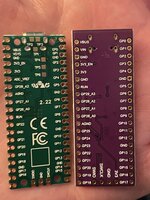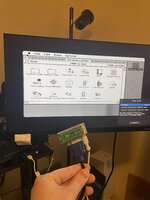quinterro
Well-known member
I'm attempting to get this working like others have done, but have not been able to compile umac within the pico-mac repository. I'm attempting it with VS Code on a 2012 MacBook Pro with Raspberry Pi's Pico extension installed. I tried some of the example projects and they compile, but their folder structure isn't as complex as the pico-mac project. I'll probably need to set up the Pico SDK, which I think the VS Code extension does for you.
I have the board from Ron's Computer Videos, but at the moment I don't have a genuine Pico board that doesn't have headers soldered to them.
I do have a few of the RP2040 clones w/16MB PSRAM that don't have soldered headers. However, there is one pin between the clone and the Pico that is different. Pin 37 on the Pico is 3V3_EN, while on the clone it is GPIO23. The clone also has 4 pins on the debug header versus 3 on the Pico board.
I'll have to check to see which pins on Ron's board are connected to ensure I'm not connecting a pin that is expecting to add 3.3 volts to a GPIO pin if I use one of the clone boards. I would like to get it working with the genuine Pico first though.
I have the board from Ron's Computer Videos, but at the moment I don't have a genuine Pico board that doesn't have headers soldered to them.
I do have a few of the RP2040 clones w/16MB PSRAM that don't have soldered headers. However, there is one pin between the clone and the Pico that is different. Pin 37 on the Pico is 3V3_EN, while on the clone it is GPIO23. The clone also has 4 pins on the debug header versus 3 on the Pico board.
I'll have to check to see which pins on Ron's board are connected to ensure I'm not connecting a pin that is expecting to add 3.3 volts to a GPIO pin if I use one of the clone boards. I would like to get it working with the genuine Pico first though.



